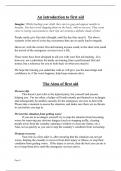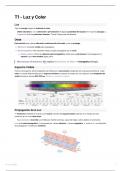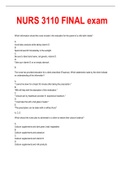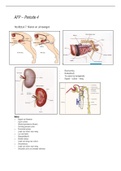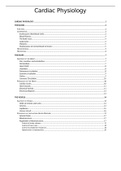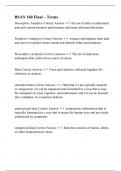Medic_Summaries (IMS) Topic 12
Muscles and Nerves
CNS: brain and spinal cord (central command centre)
- Receives, processes, interprets and stores information
- Sends messages destined for muscles, glands and organs
PNS: peripheral nerves (body’s link to outside world)
- Transmits information to and from the CNS
- Sensory and motor nerves
ANS: involuntary processes (autonomic)
- Sympathetic, parasympathetic, enteric and cardiac plexuses
- Heart rate, respiration, digestion, pupil contraction etc.
- Operates automatically, without conscious direction
- Sympathetic NS: fight/flight response
- Parasympathetic NS: rest and digestive response
SNS: relays information (somatic)
- Carries sensory information from sensory organs to the CNS
- Relays motor commands to muscles
- Controls voluntary movements
Neurone characteristics:
- Fast communication
- High metabolic rate
- Brain’s grey matter
- Many dendrites - signal input
- One axon - signal conduction
- Many synaptic terminals - signal output
Different types of neurone: size, shape, connections, functions, transmitter
- Sensory
- Motor
- Interneuronal
Multipolar neurones: single long axon, many dendrites emerging from cell body (MOTOR)
Unipolar/ pseudo-unipolar neurones: sensory ganglia (PERIPHERAL SENSORY)
Bipolar neurones: sensory structures (RETINA)
Types of neurite:
- Dendrites: short and thick projections out from the neurone cell body
- Give rise to small spines
- Spread out over a large volume of brain tissue
- Dendritic tissue: increased surface area to receive inputs from other neurones
- Axons: long and thin projections out from the neurone cell body
- Run from one brain area to another/out of CNS to bodily tissues
- Usually only one axon, but may branch off to two/more different targets
Multipolar: pyramidal/stellate
- Cerebral cortex, hippocampus, cerebellum
- Dendrites and axon visual with silver stain
Stellate: small nucleus, many projections (star-like)
Pyramidal: Christmas tree-like
1 Adapted from Lectures at the University of Leeds Medical School
,Medic_Summaries (IMS) Topic 12
White matter: spinal cord consists of axons carrying information to and from the brain
Grey matter: cell bodies in sensory and motor nuclei
Weigert’s strain: stains myelin
- White matter: stains DARK (more myelin as mostly axons)
- Grey matter: stains PALE (less myelin as mostly cell bodies)
The CNS has tracts (axons) and nuclei (cell bodies):
- Group of nerve cells - NUCLEUS
- Bundle of axons - TRACT
The PNS has nerves (axons) and ganglia (cell bodies):
- Group of nerve cells - GANGLION
- Bundle of axons - NERVE
There are four cell groups within the grey matter:
- Somatosensory: SUPERFICIAL dorsal horn
- Viscerosensory: DEEP dorsal horn
- Interneurones respond to inputs from the body’s:
- External tissues (somato) - SOMATOMOTOR: ventral horn
- Internal organs (viscero) - VISCEROMOTOR: intermediate/lateral horn
Tracts: white matter takes information up from the spinal cord to the brain
- Lateral corticospinal tract
- Rubrospinal tract
- Vestibulospinal tract
- Reticulospinal tract
- Ketospinal tract
- Anterior corticospinal tract
The PNS
- Has nerves (axons) and ganglia (cell bodies):
- Dorsal root ganglia: cell bodies of the sensory fibres together with lots of
myelinated and non-myelinated axons passing through
- Ganglia: nodular masses of neurone cell bodies (ganglion cells) and supporting
neuroglia (satellite cells)
- Has two types of ganglia:
- Sensory ganglia: cell bodies of sensory neurones
- Autonomic ganglia: cell bodies of EFFERENT neurones from the ANS
Peripheral nerves:
- Epineurium: covers WHOLE NERVE
- Perineurium: covers FASCICLE
- Endoneurium: covers INDIVIDUAL NERVE AXONS
- NB bindle of nerve fibres = fascicle
Neuroglia/Glia/Glial cells: supporting cells for neurones
- Regulate neurone metabolism and function
- Energy supply and transmitter levels
- Repair and recovery
- Regulate BBB
- Destroy pathogens
- Remove dead neurones
CNS: astrocytes, ependymal cells, oligodendrocytes, microglia
PNS: satellite cells, Schwann cells
2 Adapted from Lectures at the University of Leeds Medical School
, Medic_Summaries (IMS) Topic 12
Astrocytes:
- Extensive projections, spread out between neurones
- Used for contact and communication with neighbouring glial cells and capillaries
- Regulation of ionic concentration: pump ions, such as K+, into capillaries
- Glucose metabolism: take up glucose from blood, convert to lactate and put into
neurones for energy supply
- Neurotransmitter metabolism: take up, inactivate and recycle neurotransmitters and
metabolites
- Regulate BBB: restrict some substances entering brain’s intracellular space
- Neuronal development: produce growth factors to influence neuronal growth and guide
neurones to the correct location and targets
Glial cells:
- In the CNS:
- Astrocytes: involved in metabolic exchange between neurones and blood
- Ependymal cells: lining cells for ventricles/central spinal canal (cilia on lumen)
- Oligodendrocytes: myelinate axons, most common in WHITE MATTER
- Microglia: less common, immune defence (phagocytic)
- In the PNS:
- Satellite cells: surround nerve cell body/aid in controlling chemical environment
of neurones
- Schwann cells: form sheath around large fibres in PNS; phagocytic, engulfs
damaged/dying nerve cells, clears debris allowing regrowth of PNS neurones
Myelination of nerves:
- Oligodendrocytes (CNS)/Schwann cells (PNS) wrap axon in a spiral of concentric layers of
fatty myelinated membranes
- This provides INSULATION and aids in IMPULSE TRANSMISSION
Gaps: 0.5 um between adjacent cells (NODES OF RANVIER)
Sheath: also known as MESAXON, has no cytoplasm and is purely lipid membrane
Nodes of Ranvier: only points along the axon where ions can freely move in and out of the axon,
therefore the action potential ‘jumps’ between nodes (SALTATORY CONDUCTION)
Non-myelinated nerves: supporting Schwann cell
Mesaxon: axon embedded in a channel, Schwann cell is right next to the nerve (single Schwann
cell supports several nerves)
Nerves contain blood: specialised basement membrane to prevent blood leaking into neurone
Osmium: heavy metal, makes myelinated cells stand out under observation
Somatic NS: voluntary NS
- Somatic motor neurones (motoneurones)
- Innervates and controls voluntary, striated (stripped/streaked) muscle
- Has sensory AFFERENT fibres
- Spinal nerves: mixed, consist of EFFERENT motor and AFFERENT sensory fibres
- Motor neurones: one myelinated axon, innervates target organ (e.g. muscle)
- Sensory neurones: special endings, sensory nerve endings
Autonomic NS: involuntary NS
- Controls: heart rate, blood pressure, respiration, sweat glands, gut movements
- Sympathetic and parasympathetic systems (ANTAGONISTIC ACTIONS)
- Unconscious activity: supplies body’s visceral organs
- Sympathetic: SPEEDS UP salivary glands, lungs, heart, stomach, bladder, etc.
- Parasympathetic: CALMS DOWN salivary glands, lungs, heart, stomach, bladder, etc.
- Motor pathway: two neurone link from the CNS to target tissues
- Preganglionic neurone
- Postganglionic neurone
3 Adapted from Lectures at the University of Leeds Medical School
Muscles and Nerves
CNS: brain and spinal cord (central command centre)
- Receives, processes, interprets and stores information
- Sends messages destined for muscles, glands and organs
PNS: peripheral nerves (body’s link to outside world)
- Transmits information to and from the CNS
- Sensory and motor nerves
ANS: involuntary processes (autonomic)
- Sympathetic, parasympathetic, enteric and cardiac plexuses
- Heart rate, respiration, digestion, pupil contraction etc.
- Operates automatically, without conscious direction
- Sympathetic NS: fight/flight response
- Parasympathetic NS: rest and digestive response
SNS: relays information (somatic)
- Carries sensory information from sensory organs to the CNS
- Relays motor commands to muscles
- Controls voluntary movements
Neurone characteristics:
- Fast communication
- High metabolic rate
- Brain’s grey matter
- Many dendrites - signal input
- One axon - signal conduction
- Many synaptic terminals - signal output
Different types of neurone: size, shape, connections, functions, transmitter
- Sensory
- Motor
- Interneuronal
Multipolar neurones: single long axon, many dendrites emerging from cell body (MOTOR)
Unipolar/ pseudo-unipolar neurones: sensory ganglia (PERIPHERAL SENSORY)
Bipolar neurones: sensory structures (RETINA)
Types of neurite:
- Dendrites: short and thick projections out from the neurone cell body
- Give rise to small spines
- Spread out over a large volume of brain tissue
- Dendritic tissue: increased surface area to receive inputs from other neurones
- Axons: long and thin projections out from the neurone cell body
- Run from one brain area to another/out of CNS to bodily tissues
- Usually only one axon, but may branch off to two/more different targets
Multipolar: pyramidal/stellate
- Cerebral cortex, hippocampus, cerebellum
- Dendrites and axon visual with silver stain
Stellate: small nucleus, many projections (star-like)
Pyramidal: Christmas tree-like
1 Adapted from Lectures at the University of Leeds Medical School
,Medic_Summaries (IMS) Topic 12
White matter: spinal cord consists of axons carrying information to and from the brain
Grey matter: cell bodies in sensory and motor nuclei
Weigert’s strain: stains myelin
- White matter: stains DARK (more myelin as mostly axons)
- Grey matter: stains PALE (less myelin as mostly cell bodies)
The CNS has tracts (axons) and nuclei (cell bodies):
- Group of nerve cells - NUCLEUS
- Bundle of axons - TRACT
The PNS has nerves (axons) and ganglia (cell bodies):
- Group of nerve cells - GANGLION
- Bundle of axons - NERVE
There are four cell groups within the grey matter:
- Somatosensory: SUPERFICIAL dorsal horn
- Viscerosensory: DEEP dorsal horn
- Interneurones respond to inputs from the body’s:
- External tissues (somato) - SOMATOMOTOR: ventral horn
- Internal organs (viscero) - VISCEROMOTOR: intermediate/lateral horn
Tracts: white matter takes information up from the spinal cord to the brain
- Lateral corticospinal tract
- Rubrospinal tract
- Vestibulospinal tract
- Reticulospinal tract
- Ketospinal tract
- Anterior corticospinal tract
The PNS
- Has nerves (axons) and ganglia (cell bodies):
- Dorsal root ganglia: cell bodies of the sensory fibres together with lots of
myelinated and non-myelinated axons passing through
- Ganglia: nodular masses of neurone cell bodies (ganglion cells) and supporting
neuroglia (satellite cells)
- Has two types of ganglia:
- Sensory ganglia: cell bodies of sensory neurones
- Autonomic ganglia: cell bodies of EFFERENT neurones from the ANS
Peripheral nerves:
- Epineurium: covers WHOLE NERVE
- Perineurium: covers FASCICLE
- Endoneurium: covers INDIVIDUAL NERVE AXONS
- NB bindle of nerve fibres = fascicle
Neuroglia/Glia/Glial cells: supporting cells for neurones
- Regulate neurone metabolism and function
- Energy supply and transmitter levels
- Repair and recovery
- Regulate BBB
- Destroy pathogens
- Remove dead neurones
CNS: astrocytes, ependymal cells, oligodendrocytes, microglia
PNS: satellite cells, Schwann cells
2 Adapted from Lectures at the University of Leeds Medical School
, Medic_Summaries (IMS) Topic 12
Astrocytes:
- Extensive projections, spread out between neurones
- Used for contact and communication with neighbouring glial cells and capillaries
- Regulation of ionic concentration: pump ions, such as K+, into capillaries
- Glucose metabolism: take up glucose from blood, convert to lactate and put into
neurones for energy supply
- Neurotransmitter metabolism: take up, inactivate and recycle neurotransmitters and
metabolites
- Regulate BBB: restrict some substances entering brain’s intracellular space
- Neuronal development: produce growth factors to influence neuronal growth and guide
neurones to the correct location and targets
Glial cells:
- In the CNS:
- Astrocytes: involved in metabolic exchange between neurones and blood
- Ependymal cells: lining cells for ventricles/central spinal canal (cilia on lumen)
- Oligodendrocytes: myelinate axons, most common in WHITE MATTER
- Microglia: less common, immune defence (phagocytic)
- In the PNS:
- Satellite cells: surround nerve cell body/aid in controlling chemical environment
of neurones
- Schwann cells: form sheath around large fibres in PNS; phagocytic, engulfs
damaged/dying nerve cells, clears debris allowing regrowth of PNS neurones
Myelination of nerves:
- Oligodendrocytes (CNS)/Schwann cells (PNS) wrap axon in a spiral of concentric layers of
fatty myelinated membranes
- This provides INSULATION and aids in IMPULSE TRANSMISSION
Gaps: 0.5 um between adjacent cells (NODES OF RANVIER)
Sheath: also known as MESAXON, has no cytoplasm and is purely lipid membrane
Nodes of Ranvier: only points along the axon where ions can freely move in and out of the axon,
therefore the action potential ‘jumps’ between nodes (SALTATORY CONDUCTION)
Non-myelinated nerves: supporting Schwann cell
Mesaxon: axon embedded in a channel, Schwann cell is right next to the nerve (single Schwann
cell supports several nerves)
Nerves contain blood: specialised basement membrane to prevent blood leaking into neurone
Osmium: heavy metal, makes myelinated cells stand out under observation
Somatic NS: voluntary NS
- Somatic motor neurones (motoneurones)
- Innervates and controls voluntary, striated (stripped/streaked) muscle
- Has sensory AFFERENT fibres
- Spinal nerves: mixed, consist of EFFERENT motor and AFFERENT sensory fibres
- Motor neurones: one myelinated axon, innervates target organ (e.g. muscle)
- Sensory neurones: special endings, sensory nerve endings
Autonomic NS: involuntary NS
- Controls: heart rate, blood pressure, respiration, sweat glands, gut movements
- Sympathetic and parasympathetic systems (ANTAGONISTIC ACTIONS)
- Unconscious activity: supplies body’s visceral organs
- Sympathetic: SPEEDS UP salivary glands, lungs, heart, stomach, bladder, etc.
- Parasympathetic: CALMS DOWN salivary glands, lungs, heart, stomach, bladder, etc.
- Motor pathway: two neurone link from the CNS to target tissues
- Preganglionic neurone
- Postganglionic neurone
3 Adapted from Lectures at the University of Leeds Medical School

